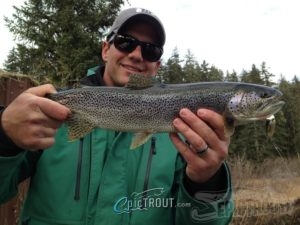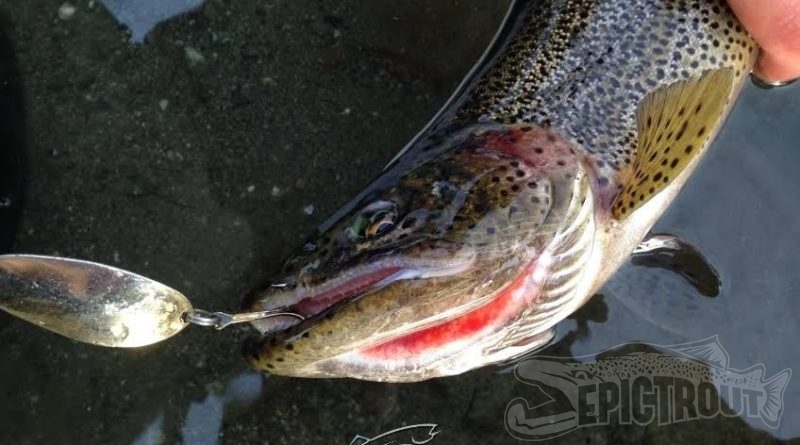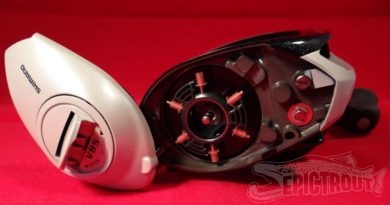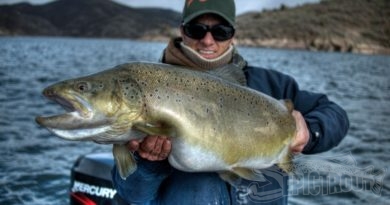Coastal Cutthroat Redemption
This is a fluff piece if there ever was one. If you value your time, you may as well quit reading this right now, because there is very little or no knowledge to be gained by reading this article. I would personally file this under “filler.” This is the article equivalent of the local news station running something on the evening news like this: “Firefighters help ducklings across street…”
On a recent trip to Yakutat, Alaska, my friends and I found very slow steelhead fishing on the Situk River. The Situk has been covered in so many magazine articles as of late, I feel that there is little else to say about it. It’s known for amazing steelhead fishing, but in our case the reality didn’t live up to the hype. In fact, the fishing really sucked. There, I said it! We got our butts whipped. Drought was the most likely cause, as it followed us all the way from Northern California to southeast Alaska. There were plenty of fish in the river, but they were all running scared with sore mouths in crystal clear water; any steelhead fisherman’s worst nightmare. Let’s just sum it all up right here by saying that my friends and I caught fish, but the fishing was nowhere near what I expected. On the last day of our trip, there was an opportunity for salvation in the form of Coastal Cutthroat Trout.
I have written about Coastal Cutthroat in the past, and some of you know that I feel they live in the same environments as Bigfoot, the Loch Ness Monster, and Unicorns. They are a very enigmatic species indeed. They can be anadromous spending much of their time in saltwater, and they can be stream or lake resident as well. However, nowhere in their range do they get very much attention, and very little is known about them. From what I’ve read, they spawn exclusively in the spring time, and they are obligatory stream spawners. That being said, they will absolutely not spend the winter months in saltwater, so they must return to freshwater. Yet, there’s a caveat, they don’t need to spend the winter in the stream they were born in. They just may be traveling along the coastline and smell a stream and think, “Hmm, this seems like a good spot to spend the winter.” Maybe I’m anthropomorphizing a bit with that statement, but it seems
accurate.
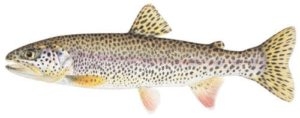
There are a few hard and fast rules that Coastal Cutthroat do follow. For starters, they feed high in the food chain if given the opportunity. Where there are plenty of salmon fry, parr, and smolts to eat, they will make their living eating them. They are very efficient predators of other salmonids, and nature seems to have balanced this propensity out by limiting their populations. I recently read in Patrick Trotter’s book, Cutthroat: Native Trout of the West, that where coastal cutthroat and Coho Salmon occur in the same drainage, Coho fry are far more fit for slow backwater environments, and they outnumber cutthroat fry by as much as 100 to 1. If steelhead fry also occur in the same stream, they out compete cutthroat in the swifter moving water, and cutthroat numbers are further limited. In other words, nature stacks the deck against cutthroat surviving to adulthood, and I can’t help but think this is nature’s way to limit the cutthroat
from eating all the other salmonids.
Here’s the bottom line: I’ve had one hell of a time targeting Coastal Cutthroat. We’ve encountered a few in far Northern California, but we’ve never slayed them. I’ve heard stories that they are common here and there, but I can’t vouch for those anecdotes. Yet, opportunity came a knockin’ in Southeast Alaska to get revenge on the mythical salmonid.
Our first encounter with Coastal Cutts in Southeast Alaska was completely fruitless. We found them in a deep hole under a bridge, and they wanted absolutely nothing to do with what we had to offer. My buddy, JW, had one grab his jig, and I had one try to eat a pink worm, but they quickly were educated to our malevolent plans. After a while, I tried putting a very small pheasant tail nymph under a bobber, and I went as far as to tell the guys, “This is guaranteed to work. I can’t believe I had this little nymph in my steelhead gear. Sit back and watch as I show you guys how this is done.” Pride cometh before the fall. Those cutthroat couldn’t care less about my little nymph.
Later in the week, we talked to Bob Miller, the owner of the Situk River Fly Shop. Bob is an extremely knowledgeable guy, and he gave us some much needed info and tips that would help us catch those enigmatic cutthroat. Bob mentioned to us that at this time of year, the cutthroat would be focused on outward migrating smolts, and they would be extremely aggressive towards anything moving quickly. It’s no wonder they didn’t want anything to do with my dead drifted nymph.
Fast forward to the fly out day of our trip, and JW and I have caught a couple of steelhead on the Situk that very morning. Unsatisfied, we plan to exact our revenge on those Coastal Cutthroat that had humbled us earlier in the week. Armed with new intelligence, we put on the smallest Little Cleo’s and Mepp’s Spinners I had in my steelhead box. Those cutthroat didn’t know what hit them. To say they were gullible was an understatement. For the first 20 or so minutes, we hook or catch one of the 100 or so fish sitting in the bridge hole on every cast. The bite began to wane, so we stood atop the bridge and vertical jigged our spoons. Unbelievably, this new presentation sparks round two of catching. I land one of the biggest fish in the hole, a 19” beauty, after watching it follow my spoon like a yo-yo and finally hitting it. Not only were we catching this rare fish, but these were some of the most beautiful specimens I’d ever seen.
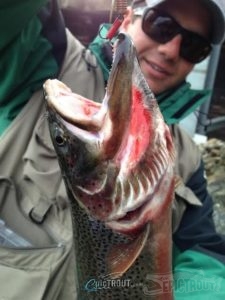
They were profusely spotted; kind of like an Alaskan leopard rainbow, but with bright red or orange slashes under their throats. Instead of the usual Coastal Cutthroat silvery backdrop, these fish had dark emerald backs and rosy hues.
So what does this add up to? Not much, but damn did it ever feel good to catch a whole buttload of those stingy fish that have frustrated me so often in the past.
